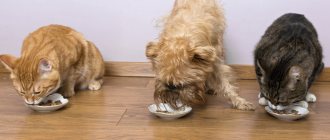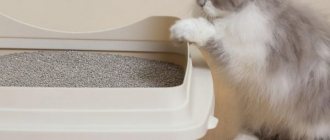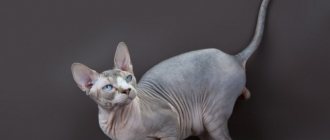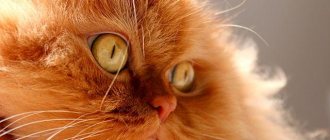Tearing in cats is normal as long as the fluid is clean and clear. But sometimes even a healthy kitten’s eyes begin to fester. The reasons may be structural features of the muzzle, improper diet, a reaction to household chemicals used by the owner, or the development of a serious pathology in the animal’s body. Let's find out how to properly wash a cat's eyes at home, and in what cases the help of a veterinarian is needed.
Why do a kitten's eyes fester?
Normally, lacrimation is necessary to protect the mucous membrane, remove foreign bodies (dust and dirt), lubricate and moisturize. If the kitten secretes a clear liquid, it will be enough to rinse the baby’s eyes and remove small crusts as necessary.
The reasons for the natural secretion of fluid from a kitten's eyes are:
- Morning tears. They are produced in all animals throughout life, do not leave marks on the fur, and are necessary for clearing the nasolacrimal ducts of clots that have formed during sleep. In this case, you don’t have to rub the kitten’s eyes.
- Protective lacrimation occurs in a more active mode. Here, the release of fluid is more intense due to the need to neutralize a possible threat to the organ of vision. Most often we are talking about specks and dust particles getting on the surface of the mucous membrane or under the eyelids, which usually come out along with the tears. In case of severe contamination, you need to rinse the cat’s eyes and monitor its further well-being. In the vast majority of cases, if timely assistance is provided, this is enough and a visit to the veterinarian is not necessary.
- Allergic reactions, which in animals manifest themselves as eye irritation and can be caused by a strong odor, low-quality products, or contact with household chemicals. The owner must determine the cause of the allergy and then wash the cat's eyes.
The main sign of natural lacrimation in a kitten is a clear liquid that does not form streaks on the fur around the eyes. But if pus appears in the discharge, this is a serious cause for concern. Most often, this is a sign of a serious pathology that cannot be treated at home without the help of a veterinarian.
Is treatment possible at home without veterinary care?
Before you start treating your kitten at home, you need to take him to an appointment with a veterinarian. It is very important to find out the real cause of inflammation. If it is accompanied by a general deterioration in health, sneezing, coughing, and upset bowel movements, the pet may be seriously ill.
Some dangerous diseases, such as calcivirosis or viral rhinotracheitis, often occur with symptoms of damage to the organs of vision. The veterinarian will examine the pet, take tests and make a diagnosis. If a serious infectious disease is detected, eye drops alone cannot be used; complex treatment will be required.
Attention! You can treat a kitten at home only after examination at a veterinary clinic.
How and what to wash a kitten's eyes with
Washing the eyelids is the first thing to do if the inflammatory process begins. You need to carefully remove crusts and discharge with a cotton pad. It is moistened in warm boiled water, saline or strong tea without additives. Each eye is wiped with a clean swab in the direction from the outer corner to the inner. On each side you will need 5-6 cotton pads or gauze pads. Do not dip a dirty swab into the rinsing solution.
Washing a kitten's eyes
A strong infusion of chamomile can also be used to cleanse crusts and pus from the eyelids. This remedy helps relieve inflammation. For brewing, it is better to take the flowers of the plant in bags. For 1 cup of boiling water you will need 4 bags of chamomile. Before using the infusion, it is important to make sure that it is not hot. The washing procedure is done 4–5 times a day.
How to put eye drops on your pet correctly
Dealing with a sick pet, even if it is small, is not so easy. The animal will resist treatment procedures. You may need an assistant to secure your four-legged friend. The cat is placed on its back and its paws are held down. A second person carefully removes the pus from the eyelids. Only after this can you use the drops.
The lower eyelid is pulled back slightly with the thumb, fixing the cat’s head so that it does not twitch. The bottle is kept at a distance of 1 cm from the eyeball, the dropper should not touch the eyelid. Inject the required amount of solution into the formed pocket. Next, do the same with the second eye.
Putting eye drops on a cat
Associated symptoms
Unlike an adult cat, a kitten’s immunity cannot fully resist diseases. Therefore, the first thing to do if a kitten’s eyes are festering is to assess its condition.
Warning signs are:
- discharge of clear or purulent fluid over a long period of time (more than a day);
- the presence of a foreign body in the kitten’s eye, which cannot be removed by rinsing;
- swelling of the eyelids or their redness;
- loss of transparency in the cornea;
- change in iris color or clouding;
- copious discharge of pus from the nose.
All of these symptoms are aggravated by fever, lack of appetite, weight loss, apathy, and photophobia. The fur around the eyes becomes unsightly, the skin in the affected areas turns red and causes suffering to the animal due to itching. In such a situation, you need to wash the cat's eyes at home. But it is better not to delay your visit to the clinic, since the listed signs require immediate assistance from a veterinarian.
Causes and symptoms of eye inflammation in cats
All cats have unusually sharp eyesight, so eye problems are really serious for your pet. Often eye diseases are symptoms of more serious disorders in the functioning of the furry body. Thus, the cause of inflammation of the visual organs may be a genetic predisposition to this (especially among Persians and British), mechanical trauma (a foreign object entering the eye) or internal pathologies. The main symptoms of inflammation are redness of the organs of vision, aggression, lethargy, swelling of the eyes, and the release of tears or other fluids.
Diagnostics
When a kitten’s eye festers, the doctor decides how to treat it. Modern diagnostic procedures do not take much time and do not cause discomfort to the animal.
Before visiting the doctor, it is better not to feed the kitten, as the veterinarian may order a laboratory blood test.
On the day of visiting the clinic, kittens do not wash their eyes - this will blur the overall picture of the discharge and make it difficult to make an accurate diagnosis.
The reasons why a cat’s eye is watery or purulent are determined using the following methods:
- Schirmer's test - determines the amount of tear fluid that is necessary to maintain the natural level of humidity;
- biomicroscopy – studies the condition of the connective membrane, iris, vitreous body, lens;
- measurement of intraocular pressure - the difference between the addition and outflow of moisture is determined;
- Ultrasound – examination of all structures of the organ of vision;
- examination of the optic nerve and retina;
- checking the patency of the nasolacrimal ducts.
Treatment
A veterinarian-ophthalmologist prescribes treatment only after making a diagnosis. Most often it is associated with the neutralization of another inflammatory process, which caused the appearance of pus.
- Conjunctivitis is the most common eye disease in kittens. Pathology can be caused by trauma, chemical burns, parasites or viral infections. The eyes of kittens fester especially profusely during the acute course of the disease. The mucous membranes become inflamed and red, discharge from clear to purulent appears, the eyelids swell and stick together. As treatment, the doctor prescribes eye drops, ointments, and in the most severe cases, antibiotics.
- Keratitis develops as a consequence of mechanical trauma, as well as as a result of disruption of the process of secretion and outflow of tear fluid. The cat's eyes secrete pus, the cornea becomes cloudy, and fluid accumulates inside it, causing photophobia to develop. In the initial stage, the disease can be cured with ointment, gel and drops. The veterinarian also prescribes medications to strengthen the immune system.
- Districhiasis is a hereditary disease that manifests itself in the reverse growth of eyelashes. Occasionally we are talking about hair that does not grow properly in the eye area. The hairs get on the cornea, irritate the mucous membrane, cause pain and can cause mechanical injuries, as a result of which the cat’s eye festers. Due to the microscopic size of the hair, which is not visible during a superficial examination, it is impossible to clean a kitten’s eyes on your own. In this case, fluid is released abundantly, the eyes become very suppurated, and various complications develop. Treatment involves surgery.
- Blepharitis is inflammation of the eyelids. The symptoms of blepharitis are similar to conjunctivitis. There are 7 types of the disease (simple, scaly, ulcerative, demodectic, allergic, phlegmonous and meibomian). Blepharitis can be mild or cause complications. At the same time, the kitten’s eyes fester, the nose becomes crusty, skin irritations appear, immunity decreases and complex pathologies of internal organs develop.
Important! When a cat’s eyes do not open and fester, this means that the disease has reached an acute stage and the pet must be urgently shown to a veterinarian.
How to distinguish dangerous lacrimation from non-dangerous ones
With pathological
When your cat has watery eyes, problems appear in one or both eyes. The discharge is thin or mucous, brown or slightly whitish.
The nature of the discharge can vary from liquid and transparent to thick, purulent. Typically, pathological lacrimation is accompanied by the animal's anxiety and itching: the cat constantly washes itself and rubs its eyes with its paws.
Body temperature may rise, red eyes, and swelling of the eyelids may appear. Crusts form in the corners of the eyes and hair falls out. When only one eye is watery, the cat squints it and rubs it with its paw. Pathological lacrimation may be accompanied by lethargy of the pet, poor appetite and other signs of illness.
With a sick animal, you should go to the veterinarian to get advice, understand the causes of the disease and take all necessary measures. Timely treatment will help avoid dangerous complications such as infection and blindness.
Tearing in cats can also occur due to
natural
causes. For example, after sleep one eye waters and does not open. This is not dangerous: the eye should be rinsed with boiled water or chamomile decoction.
Long-haired cats often have excessive tearing due to hair getting into the tear duct and the accompanying irritation. Breeders are advised to trim the long hair on the face of a long-haired cat and brush the pet regularly.
Due to the anatomical features of the structure of the skull and the short nasolacrimal ducts in the British, Scots and Persians, lacrimation is a normal variant. These cats cry almost constantly without experiencing any discomfort. Breeders of such cats need to take good care of their pet’s hygiene and periodically treat their eyes and face.
What medications and remedies can the doctor prescribe?
In most cases, you can treat your kitten's eyes at home. It is only important to make a correct diagnosis and get recommendations from a specialist on the use of drugs. Many of them are sold in regular pharmacies and are well known to cat owners:
- Tetracycline ointment is an antibiotic with a wide range of action. Penetrates deep into the festering eye and effectively relieves inflammation.
- Tsiprolet is an anti-inflammatory drug. It is dropped into the kitten's eyes every 3-4 hours.
- Tsiprovet is an analogue of Tsiprolet, destroys harmful microorganisms that parasitize the mucous membranes. Quickly suppresses suppuration, the kitten's eyes are cleansed of dirt and pus.
- Levomycetin affects bacteria that are not susceptible to penicillin derivatives. It has proven itself in the treatment of diseases such as keratitis, blepharitis, conjunctivitis and others.
- Leopard contains furacilin and chloramphenicol. Works in a wide antibacterial range, effectively relieves purulent inflammation in the eyes of a cat.
- Iris is developed on the basis of gentamicin sulfate. The drug is prescribed for acute and chronic conjunctivitis, corneal ulcers, wounds and injuries of the visual organs.
The next group of remedies belongs to the section of traditional medicine. These methods can be used for minor tearing; they are absolutely safe due to their natural composition:
- Chamomile decoction is used to wash a cat's eyes at home;
- Calendula tincture is suitable for treating the eyes and nose;
- violet and celandine will help cure conjunctivitis;
- fresh strong black tea is used to wash the kitten’s eyes and remove dried crusts.
Important! Do not use tea bags for rinsing. It may contain adhesives that are harmful to cats' eyes.
Conjunctivitis
This is the name for inflammation of the mucous membrane of the eye - the conjunctiva. The conjunctiva is the tissue that covers the outside of the eye and the inside of the eyelids. Its main function is to protect the eye from mechanical particles and infection, as well as the secretion of fluid that lubricates the eye. This disease is quite common and can be either independent or a complication of other health problems. The main symptoms of this disease are redness of the cat's eyes, swelling of the eyelids, and discharge from the eyes. The most common causes of this disease include the following:
- internal inflammation of the eyes; - inflammation of the eyelids and cornea; - injuries to the mucous membrane - conjunctiva, eyelids, cornea, as well as the eye itself; - irritants, which include cigarette smoke, and foreign materials: particles of garbage, sand, etc.; — infectious diseases, including chlamydia, herpes, etc.; - an allergic reaction, although, as practice shows, dogs are more predisposed to allergic conjunctivitis.
Veterinarians distinguish between primary and secondary conjunctivitis. Primary occurs due to various injuries, while secondary accompanies other diseases. In any case, before starting to treat conjunctivitis in a cat, it is necessary to correctly determine the cause of the disease. If the inflammation was caused by a foreign body, then it is necessary to remove it and thoroughly rinse the eye with sterile saline solution. If the root cause is an upper respiratory tract infection (calcivirosis, chlamydia, etc.), then the treatment of conjunctivitis will be supportive until the cause of its occurrence is eliminated. In this case, antibiotics, such as tetracycline ointment, can be used. If a pet has had infectious rhinotracheitis (herpes), the virus will remain in the body, and as a result of stress, conjunctivitis can occur for the rest of its life - treatment will be supportive. Whatever the underlying cause, it must be determined by a veterinarian. Only a specialist can prescribe the correct treatment and save your cat’s eyes. The owner’s task is to deliver the pet to such a specialist in a timely manner.
Read more about this disease: Symptoms and treatment of conjunctivitis in cats
How to drip drops and apply ointment to a kitten's eyes
Drops and ointments are applied as follows:
- First, the festering eyes are cleared of crusts. To do this, a cotton swab is moistened in the solution, the pet is placed on the knees and fixed with one hand, and the eye is treated with uniform movements from the inner corner to the outer with the other. It is necessary to moisten the entire surface with the solution, then wait until the crust softens and carefully remove it with your fingers or a cotton pad.
- To administer eye drops, you need to carefully push the eyelids apart with the fingers of one hand, and quickly perform the necessary manipulations with the other hand. The eye is then closed and gently massaged to distribute the medication evenly.
- The ointment is applied to the upper and lower corners of the eyelids, close them and perform light massaging movements to distribute the product evenly over the eyeball.











